From farm to prison
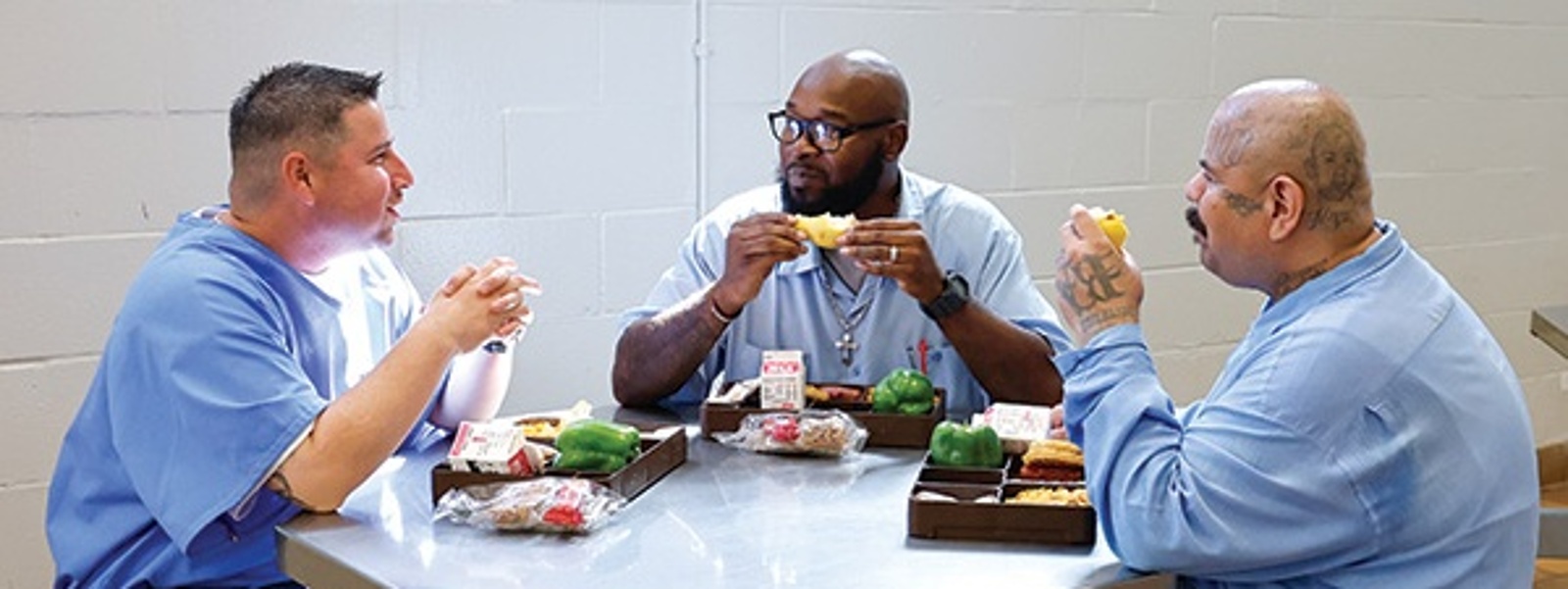
Spring 2024 California Bountiful magazine
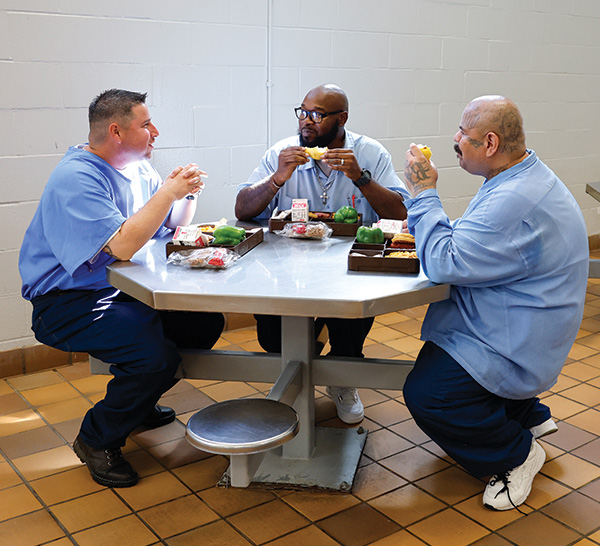
Program benefits inmates, small farms and local economies
Story by Linda DuBois
Prison photos by Fred Greaves
Spork Food Hub photos by Evett Kilmartin, courtesy of UC Regents
Patrick Range sat down to brunch in the inmate cafeteria at California State Prison, Solano and immediately reached for the farm-fresh Bartlett pear on his tray.
After sampling the fruit, Range smiled broadly: “Best thing I’ve ever had!”
Range and his fellow inmates usually receive fruit each day, but fresh pears are very rare. The prison must feed each of the 3,700 inmates for $4.30 a day, and pears can cost twice as much as apples, says Gina Schnabel, the prison’s assistant correctional food manager.
“We’re given a budget we have to stay in, so we usually just get food from the lowest bidder,” Schnabel says. “We usually go with apples and bananas or sometimes oranges or canned fruit. In the summer, we’ll do cantaloupe and watermelon on occasion if we can get them in bulk bins.”
The pears were provided thanks to Harvest of the Month, a program launched last summer that brings one local seasonal fresh fruit or vegetable to state prisons each month.
It’s a collaborative effort among the California Department of Corrections and Rehabilitation, the University of California, two national nonprofits and local food hubs that pool farms’ harvests to serve large institutions.
It kicked off with three CDCR facilities—the Solano prison, California Medical Facility and Folsom State Prison—and is increasing by three more quarterly until October 2025, when all 33 adult institutions that serve more than 95,000-plus inmates will be covered, officials say.
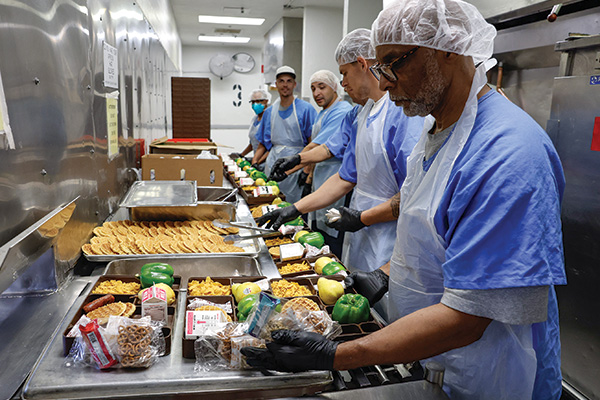
Grateful inmates
One goal is to offer fruits and vegetables that aren’t commonly served in daily meals, such as August’s pluots and October’s persimmons—two fruits Range, who’s been incarcerated for 23 years, says he’d never even heard of before trying them.
“These guys love anything new. It’s really special to them,” Schnabel says. “We try to look for opportunities to buy something that they don’t get in every single rotating menu. Harvest of the Month has really helped us with that.”
Justin Romero, incarcerated for 14 years, says “getting something other than a banana or an apple” means more than people could imagine. “In the real world, you take it for granted, but here it matters enough to make someone’s day.”
“Fruits and vegetables make any meal so much better—so, so much better,” Range adds. “A bell pepper and onion in a Top Ramen make such a big difference.”
But he has an even bigger reason to appreciate a variety of fresh produce. “I have kidney failure, so I want the nutritional value to help with my condition,” he says, adding that he always reads the nutrition information on the posters about the featured produce item that’s included with each month’s delivery. And, he says he feels better when he eats more fruits and vegetables. “You feel the difference. It’s a big, big difference.
“This Harvest of the Month program is what I’ve hoped for,” Range says, adding he had just been thanking Guadalupe Alvarez, the prison’s correctional food manager, for helping to bring in the program. “I told her it’s so appreciated.”
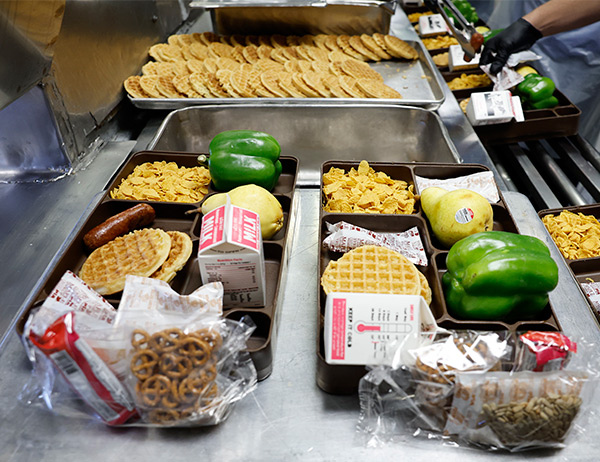
Practical benefits
The California Department of Corrections and Rehabilitation, in general, is moving toward making prison life seem as much like normal life as possible, and that includes what inmates find on their meal trays, says Lance Eshelman, who, as the CDCR’s departmental food administrator, oversees all the state prisons’ food managers. “This program gives our staff the ability to say, ‘Hey, we see you. We see that you’re an individual’ … and it makes the population feel like their voices are heard.”
But as much as Harvest of the Month serves the nutritional and psychological interests of inmates, it also serves several practical purposes.
It’s helping state prisons meet the mandates of Assembly Bill 778, which requires that, by the end of 2025, at least 60% of food purchased by state-run institutions must be grown or produced in California, Eshelman says.
“It’s taken some time and effort to train the institutions’ food services staff with a different mindset,” Eshelman says. “For years, the training has been, ‘Get the best price.’ I will say, though, that often the best price is coming out of Mexico … but there’s obviously value in getting a fresher product and supporting local farms and businesses.”
The CDCR purchases more than $163 million in food each year, and Eshelman feels good about keeping more of those dollars in California.
He’s focused now on “working with the local food hubs to figure out a price point that works for everybody. I think that’s our biggest hurdle right now.”
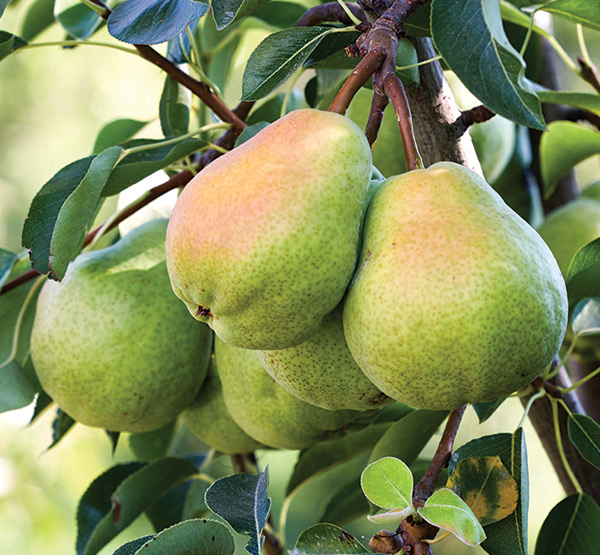
Market for farmers
The first food hub he worked with was Spork Food Hub in Davis, which has participated in Harvest of the Month since its kickoff on the Fourth of July with deliveries of watermelon.
The hub was founded in 2021 by Hope Sippola and Shayne Zurilgen, owners of the 5-acre Fiery Ginger Farm in West Sacramento, to pool the harvests of local small farms to supply produce to institutions looking for large, bulk purchases. It has since grown to work with more than 40 year-round and seasonal farms from throughout the Sacramento region and as far away as coastal areas and Fresno.
Almost two years ago, Spork was approached by Impact Justice, an Oakland-based national nonprofit that works to improve the conditions and outcomes of inmates during and after incarceration, and was key in getting Harvest of the Month off the ground.
“They had been working for some time to bring California-grown fresh fruit and vegetables into the prisons, and they were looking for a distributor that was willing to work with them,” Sippola says.
Seeing the potential, Sippola and Zurilgen began discussions with Impact Justice representatives, who connected them with Eshelman of CDCR.
“It was a lengthy process,” Sippola says. “We chatted about details, pricing and how the program would work for about a year before we made the first sale and delivery. This was a huge change for CDCR, and there was a lot of paperwork to get us set up as a vendor, as well as for security clearances for drivers and so on.”
There’s also ongoing administrative work. “There’s a lot of stuff that’s involved in it that farmers probably aren’t going to have the time or capacity to work with,” she says. “We field all those things, we deliver for them and we market for them.”
Sippola says the hub supports family farms and new and ethnically diverse farmers, adding, “We’re traveling less distance to get the food for these large institutions. We don’t purchase anything that doesn’t come from California, whereas other types of distributors tend to purchase from Mexico also. We’re only seasonal and only local.”
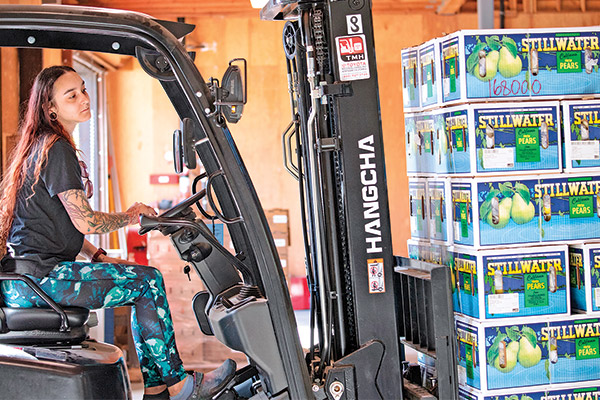
A ‘win-win-win’
Harvest of the Month is the result of about three years of behind-the-scenes research and planning among the stakeholders, says Heile Gantan, a program associate with Impact Justice’s Food in Prison Project, which aims to improve the quality and nutritional value of food in the nation’s prisons.
Other key contributors include the Nutrition Policy Institute, a University of California Agriculture and Natural Resources organization that studies the impact of nutrition and physical activity on public health, and ChangeLab Solutions, a nonprofit that shares research, policy and planning expertise to advance health equity.
In the end, the team effort came up with a program that “is really a win-win-win situation,” Gantan says, noting the CDCR can more easily comply with recently passed legislation, the inmates have more access to tasty and nutritious produce, and California’s small farms have access to a new, stable market.
“We look at our small farmers here in California, and there’s such a need to help uplift them and empower them,” she says. “This program can help do that.”
She adds that even people with no connection to the state prison system should be interested in Harvest of the Month’s physical and psychological benefits to inmates.
“It’s a public health concern. The more people who come home healthier, the less stress and burden on our public systems, our health care system and insurance,” Gantan says. “We also hope that once they come home from incarceration, they’re able to make healthier, more informed choices once they can purchase food on their own.
“If we look out for the holistic health of individuals while they’re incarcerated, then when they’re released, they’ll come home a lot more ready to contribute positively to society.”
Food hubs can provide small farms with large markets
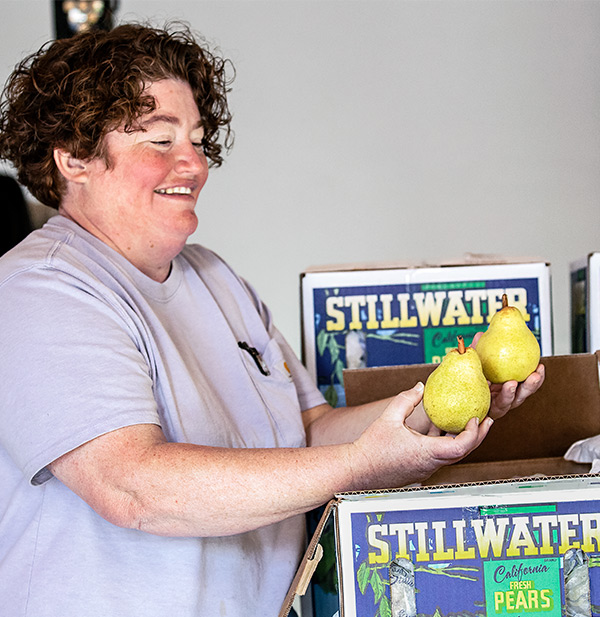
Selling food to a large institution, such as a school, hospital or prison, can give farmers a stable, reliable source of income. Yet small farmers can lack access to these markets. Distributors that supply food to these large facilities find it far more efficient to work with farms that can sell them large quantities.
But through food hubs, farms of all sizes can pool their harvests and distribute them in bulk.
“Even if a small, beginning, 1-acre farm has four cases of something, we can add it to an order with the giant farms or the mid-sized farms,” says Hope Sippola, who co-owns Spork Food Hub in Davis. “It’s a very valuable market for those smaller farms as an entry into wholesale. It creates consistency in orders for the farmers, larger orders and (depending on what they grow) year-round sales.”
Sippola speaks from experience. She and Shayne Zurilgen co-own Fiery Ginger Farm, which sits on a small plot behind a retail shop in suburban West Sacramento.
“For our first eight years of operation, our farm sold mainly to school districts,” she says. “But we’re one tiny little 5-acre farm, so we’re not going to be able to supply everything the schools need.”
Then, during the COVID-19 pandemic when the local schools had taken on a food-distribution role in impoverished communities and food-desert areas, they faced supply chain problems.
“They couldn’t get the things they needed. They were facing lots of substitutions. Things were having to travel really great distances to get to them,” Sippola says.
Then one of the schools pitched an idea to Sippola and Zurilgen. “They said, ‘You should start a food hub and just source from all your local farm friends and your own farm.’ And we said, ‘No. That seems like a lot of work,’” she says, laughing.
But they reconsidered. They wrote a California Department of Food and Agriculture grant and used a portion of that money to start the food hub in 2021.

